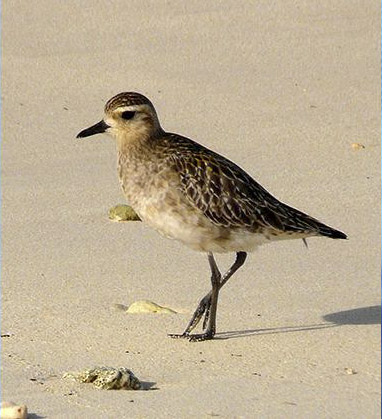Published in the Ocean Watch column, Honolulu Star-Advertiser © Susan Scott
August 10, 2015
- A kolea, or golden plover, makes a midwinter stop at Midway Atoll. The birds split time between Hawaii and Alaska, where they mate, lay eggs and raise their chicks. ©2015 Susan Scott
I am so excited that I had to tell someone,” emailed my neighbor Joanne. “My kolea is back!”
This message was one of several I received last week reporting sightings of Hawaii’s much-loved migratory shorebird, the Pacific golden plover, or kolea in Hawaiian.
As much as we love our lovely little plover pals, facts about the species can be hard to find. The following are questions from readers. My answers come from kolea researcher Wally Johnson’s published studies.
Question: How long do kolea live?
Answer: The average bird lives six to 10 years, but some live longer. One kolea wintered in a grassy field at Bellows Air Force Station for 21 years, three months.
Q: How long does it take for the birds to reach Alaska?
A: Kolea fly to their tundra breeding grounds, 3,000 or so miles from Hawaii, over open ocean in three days, about 72 hours. Their return flights to Hawaii take about four days due to adverse winds.
Q: Do kolea have chicks in Hawaii?
A: Never. Mating, egg laying and chick rearing all occur in Alaska.
Q: When do kolea migrate?
A: Underweight birds stay in Hawaii all summer. Healthy birds with enough fat stores to make the trip (the birds know) all leave around April 25, likely cued by day length.
Birds with failed nests due to predators or bad weather can return to Hawaii as early as June. Adults that successfully raised chicks come back in August, with females usually arriving before males. Juveniles appear in October and sometimes as late as November depending on fall weather.
Q: I have a kolea in my yard year after year. Is it the same bird?
A: Yes. Both male and female kolea return to, and defend, the same wintering site year after year.
Q: How do I tell a male from a female?
A: In winter you can’t. Both sexes molt into the same winter colors soon after they arrive in Hawaii. Keep watching, though. In spring the birds molt again. Males are brighter than females and have distinct edges to their black, white and gold feathers.
Over the decades, our kolea have learned to graze on grass and pavement, rest on rooftops and fence posts and steer clear of cars, cats and dogs. As a result of this remarkable adaptation to urban life, the birds give us city dwellers a heartfelt connection to nature.
That’s why a lot of us this month are so excited that we have to tell someone: My kolea is back!
